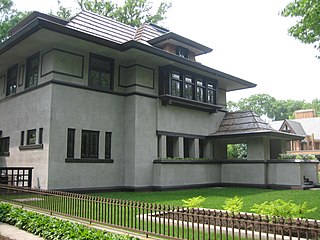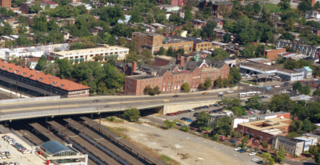
Copp's Hill is an elevation in the historic North End of Boston, Massachusetts. It is bordered by Hull Street, Charter Street and Snow Hill Street. The hill takes its name from William Copp, a shoemaker who lived nearby. Copp's Hill Burying Ground is a stop on the Freedom Trail.

The Simpsons’ house is the residence of the Simpson family in the animated sitcom The Simpsons and in The Simpsons Movie. The house's address is most frequently attributed as 742 Evergreen Terrace. In the series, the house is occupied by Homer and Marge Simpson and their three children: Bart, Lisa, and Maggie.

The Margaret Esherick House in Philadelphia is one of the most studied of the nine built houses designed by American architect Louis Kahn. Commissioned by Chestnut Hill bookstore owner Margaret Esherick, the house was completed in 1961. In 2023, the house was listed on the National Register of Historic Places by the United States Department of the Interior.

The Sam Kee Building, located at 8 West Pender Street in Vancouver, British Columbia, Canada, is the "narrowest commercial building in the world" according to the Guinness Book of Records.

A spite house is a building constructed or substantially modified to irritate neighbors or any party with land stakes. Because long-term occupation is not the primary purpose of these houses, they frequently sport strange and impractical structures.

The Edward R. Hills House, also known as the Hills–DeCaro House, is a residence located at 313 Forest Avenue in the Chicago suburb of Oak Park, Illinois. It is most notable for a 1906 remodel by architect Frank Lloyd Wright in his signature Prairie style. The Hills–DeCaro House represents the melding of two distinct phases in Wright's career; it contains many elements of both the Prairie style and the designs with which Wright experimented throughout the 1890s. The house is listed as a contributing property to a federal historic district on the U.S. National Register of Historic Places and is a local Oak Park Landmark.

The Old Stone House is one of the oldest structures in Washington, D.C. The house is also the last pre-revolutionary colonial building in Washington, D.C. Built in 1765, Old Stone House is located at 3051 M Street, Northwest in the city's Georgetown neighborhood. Sentimental local folklore preserved the Old Stone House from being demolished, unlike many colonial homes in the area that were replaced by redevelopment.

The Suntop Homes, also known under the early name of The Ardmore Experiment, were quadruple residences located in Ardmore, Pennsylvania, and based largely upon the 1935 conceptual Broadacre City model of the minimum houses. The design was commissioned by Otto Tod Mallery of the Tod Company in 1938 in an attempt to set a new standard for the entry-level housing market in the United States and to increase single-family dwelling density in the suburbs. In cooperation with Frank Lloyd Wright, the Tod Company secured a patent for the unique design, intending to sell development rights for Suntops across the country.

The pie house, sometimes referred to as the Deerfield pie house or the Deerfield skinny house, is a two-story house located in Deerfield, Illinois, United States. It is located at 970 Chestnut Street, and is near the Deerfield Metra station. The beige-sided house was built to fit a narrow lot and has attracted attention due to its unusual shape. The house is not rectangular, but rather trapezoidal, and attained its primary nickname due to its resemblance to the shape of a slice of pie.

75½ Bedford Street is a house located in the West Village neighborhood of New York City that is only 9 feet 6 inches wide. Built in 1873, it is often described as the narrowest house in New York. Its past tenants have included Edna St. Vincent Millay, author Ann McGovern, cartoonist William Steig and anthropologist Margaret Mead. It is sometimes referred to as the Millay House, indicated by a plaque on the outside of the house. The house is located in the Greenwich Village Historic District, but is not an individually designated New York City Landmark.

The Norwayne Historic District, or Norwayne Subdivision, is an historic residential subdivision, originally built for World War II defense workers. It is located in Westland, Michigan and roughly bounded by Palmer Road on the north, Wildwood Road on the west, Merriman Road on the east, and Glenwood Road and the Wayne County Lower Rouge Parkway on the south. It was listed on the National Register of Historic Places in 2013.

A byelaw terraced house is a type of dwelling built to comply with the Public Health Act 1875. It is a type of British terraced house at the opposite end of the social scale from the aristocratic townhouse but a marked improvement on the pre-regulation house built as cheap accommodation for the urban poor of the Industrial Revolution. The term usually refers to houses built between 1875 and 1918.

The Skinny House in Mamaroneck, New York, was built in 1932 by African-American carpenter and building contractor Nathan Thomas Seely on an extremely narrow lot of donated land after he lost his home to foreclosure and his company to bankruptcy during the early years of the Great Depression. The 10 feet (3.0 m) wide house has 3 stories and was built on a 12.5 feet (3.8 m) wide plot of land sold to him by his neighbor, to whom he had earlier sold a larger plot of land. The house was constructed entirely from salvaged materials. The New York State Board for Historic Preservation noted “its efficient and beautiful design, careful engineering, and effective interior plan. Challenged by a narrow lot and minimal financial means, Seely created a house that demonstrated both his ingenuity and the desire to provide, above all else, housing for his family.” The Westchester County Historical Society said “its professional construction and ingenious design are a testimony to the dedication of a prominent black contractor to build a solid, functional, and delightful home. It represents both black enterprise and good neighborliness, and is architecturally significant as a symbol of American ingenuity and craftsmanship.”

The Conductor's Building is a former Boston Elevated Railway (BERy) administrative building, located on Bennett Alley between Mount Auburn Street and Bennett Street near Harvard Square in Cambridge, Massachusetts. Built in 1912 as the headquarters of BERy's 7th Division, it is the only original building surviving from the construction of the Cambridge subway. After being renovated from 2014 to 2017 as part of an adjacent hotel project, the building was used as a restaurant from April 2017 to August 2018. Under the name Boston Elevated R.Y. Offices, it is a contributing property to the Harvard Square Historic District.

The Hendel Building, more commonly known as the Skinny Building, is a commercial building in Downtown Pittsburgh, Pennsylvania. At only 5 feet 2 inches (1.57 m) wide, it is one of the narrowest commercial buildings in the world, rivaling the Sam Kee Building in Vancouver which is considered the narrowest by Guinness World Records. The Kee building is 4 feet 11 inches (1.50 m) wide at the ground floor, but has overhanging bay windows on the second floor that extend to 6 feet (1.8 m). The Skinny Building's narrow lot was created in 1903 by a street widening project, and the building itself was constructed in 1926 by Louis Hendel, partly out of spite for neighboring business owners who complained about him obstructing the sidewalk with his fruit-selling business. Due to the building's impractical dimensions, the second and third floors have not seen much use, but the ground floor has housed a number of different businesses including a popular lunch counter. It is listed on the National Register of Historic Places as a contributing property in the Fourth Avenue Historic District.

The Home for the Aged Men and Women also sometimes known as the Home for the Aged, Poor and Infants was a charitable organization located on H Street NE between 2nd Street NE and 3rd Street NE next to the train line running down I Street NE. This was a working-class neighborhood next to Swampoodle. It was organized and managed by the Little Sisters of the Poor and provided housing, food and care for elderly men and women who had no relatives to take care of them, regardless of religion or race. The Sisters would beg for their needs as well as for those of their residents as prescribed by their order. It opened on March 19, 1873, and expending for the rest of the 19th century. It became a place of life for many older destitute individuals with the yearly distraction of the high society of diplomats and socialites of Washington, D.C., visiting the home on Saint Joseph's Day. I survived the 1968 riots but was a victim of the 1970s urban movement focused on freeways and cars. Today, it is a luxury apartment complex off of H Street and its many restaurants and bars.

The Hollensbury Spite House is a spite house located at 523 Queen Street in Alexandria, Virginia. The narrow building measures 7-feet 6-inches wide and is often called the skinniest house in the United States. The house has drawn international attention, being covered by numerous news outlets, and was once featured on The Oprah Winfrey Show. It is frequently visited by tourists who often pose in front of the building and is also included on local history tours. The house is 350 square-feet but also includes an outdoor patio and garden, providing additional entertaining space. Because of its narrow front door and small interior space, the house is decorated with smaller furniture pieces and antiques.

The Lincoln House was an architecturally significant residence in Lincoln, Massachusetts. The house was designed by noted architect Mary Otis Stevens along with her partner and husband Thomas McNulty. It was completed in 1965; the McNulty family lived there for the next 13 years. It then became home to noted opera conductor and stage director Sarah Caldwell, who sold it in 1999. The house was demolished that year, and another was built on the site by 2000.

The Arcadia Hotel fire occurred on December 3, 1913 in a flophouse on the corner of Washington and Laconia Streets in Boston's South End. The fire killed 28 persons, making it the deadliest in Boston at that time, passing the Great Boston Fire of 1872.

The Sample—Lindblaum House, also spelled Sample—Lindblom House and alternatively known as the Odile Babb House, is a historic house in Wakonda, South Dakota. It is the only Lustron home in Wakonda. It was listed on the National Register of Historic Places in 1998.






















